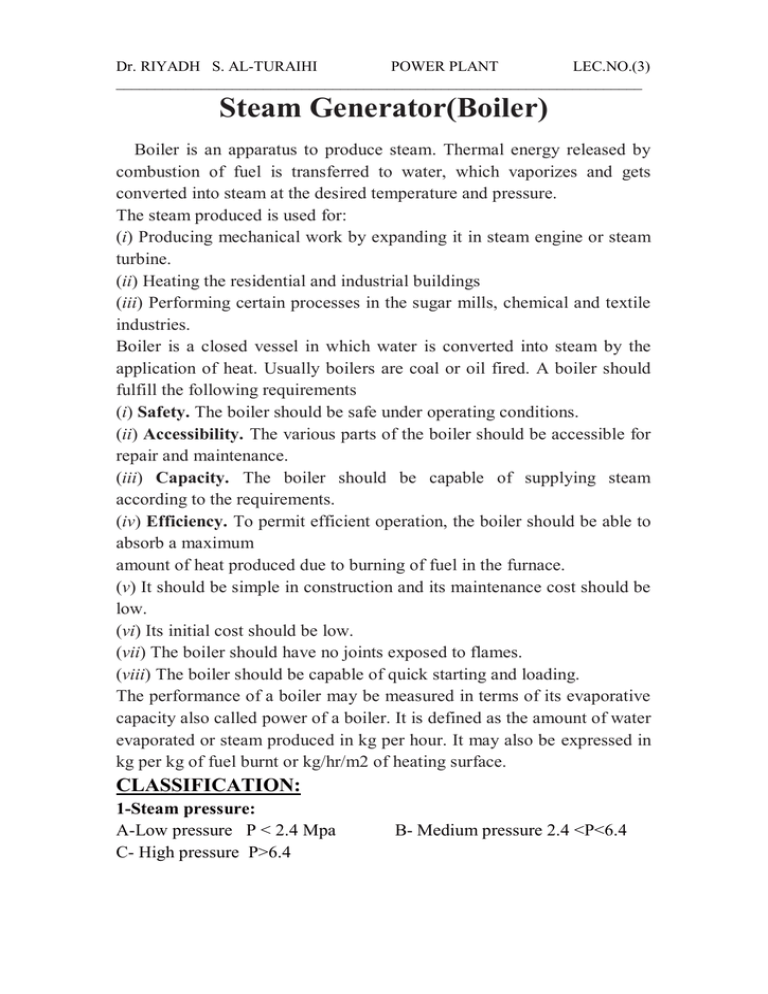Dr. RIYADH S. AL-TURAIHI ... ____________________________________________________________________
advertisement

Dr. RIYADH S. AL-TURAIHI POWER PLANT LEC.NO.(3) ____________________________________________________________________ Steam Generator(Boiler) Boiler is an apparatus to produce steam. Thermal energy released by combustion of fuel is transferred to water, which vaporizes and gets converted into steam at the desired temperature and pressure. The steam produced is used for: (i) Producing mechanical work by expanding it in steam engine or steam turbine. (ii) Heating the residential and industrial buildings (iii) Performing certain processes in the sugar mills, chemical and textile industries. Boiler is a closed vessel in which water is converted into steam by the application of heat. Usually boilers are coal or oil fired. A boiler should fulfill the following requirements (i) Safety. The boiler should be safe under operating conditions. (ii) Accessibility. The various parts of the boiler should be accessible for repair and maintenance. (iii) Capacity. The boiler should be capable of supplying steam according to the requirements. (iv) Efficiency. To permit efficient operation, the boiler should be able to absorb a maximum amount of heat produced due to burning of fuel in the furnace. (v) It should be simple in construction and its maintenance cost should be low. (vi) Its initial cost should be low. (vii) The boiler should have no joints exposed to flames. (viii) The boiler should be capable of quick starting and loading. The performance of a boiler may be measured in terms of its evaporative capacity also called power of a boiler. It is defined as the amount of water evaporated or steam produced in kg per hour. It may also be expressed in kg per kg of fuel burnt or kg/hr/m2 of heating surface. CLASSIFICATION: 1-Steam pressure: A-Low pressure P < 2.4 Mpa C- High pressure P>6.4 B- Medium pressure 2.4 <P<6.4 Dr. RIYADH S. AL-TURAIHI POWER PLANT LEC.NO.(3) ____________________________________________________________________ 2-Steam output: A-Small capacity ̇ <10 ton/hr B-medium capacity 10 < ̇ <50 ton/hr C-High capacity 50 < ̇ <150 ton/hr D- Super high capacity ̇ >150 ton/hr 3- Water content: A- With high water content. B- With low water content. 4-Tube arrangement: A-Fire tube (shell) B-Water Tube Boiler 5-Material: A-Cost Iron B- Steel 6-Setting: A-Brick set B- Portable 7-flue gas travel: A-Single pass 8- Draft: A-direct up draft 9-fuel type: A- oil B-Multi pass B-direct down draft B-gas C-coal Content: 1-Water container 2-Heating device Steam Formation And Thermal Efficiency Improvement Methods: 1-Superheated steam: Wet steam is passed through the superheated which consist of along tube or series of tube suspended across the path of the hot gases from furnaces .The degree of superheat is controlled by injection of water or steam in the superheated steam. 2-Reheater: Dr. RIYADH S. AL-TURAIHI POWER PLANT LEC.NO.(3) ____________________________________________________________________ An improvement of cycle thermal efficiency can be achieved by installation of a reheater, to avoid wet steam in the low-pressure stages of the turbine. 3-Economizer: The flue gases are passed into the economizer, which is a heat exchanger to heat feed water into the boiler. 4-Air preheater: The flue gases are still hot, further efficiency improvement can be obtained by passing then into the air heater which is a heat exchanger used to heat the air ducted to the furnace to get high furnace temperature ,more steam and hence high efficiency. 5-Attemperator: In which the steam temperature is reduced by removing heat from the steam: 1-Tubular type: in this case, the boiler water is used as a cooling medium. 2-water injection: water from the boiler is sprayed directly into the steam .This water is evaporated ,hence the temperature of mixture is reduced. Steam generator: Is a complex combination of economizer ,boiler, super heater, reheater and preheater Boiler heating surface: Heating surfaces either direct or indirect: 1-Direct surfaces: Are those through which the light or fire shines. They are effective for heat transfer to water. 2-Indirect surfaces: Are those in contact with flue gases. Types: a- fire tubes boilers: in which hot gases pass through tubes surrounded by water b-water tube boilers: In which water circulates through tubes surrounded by hot gases.


